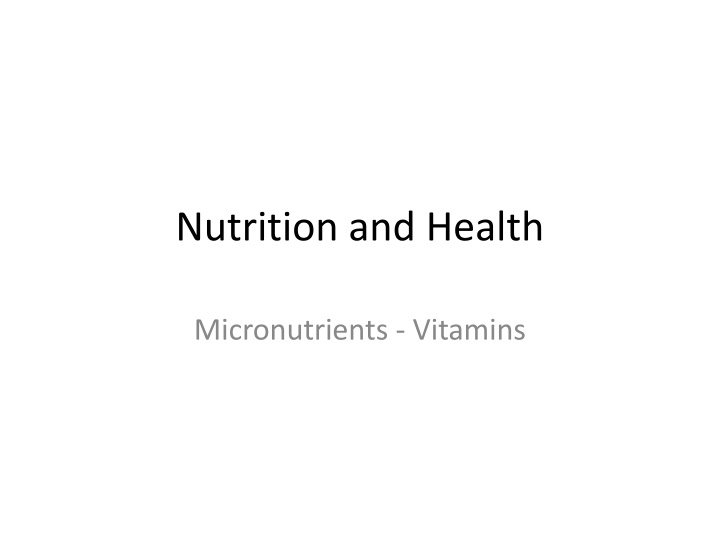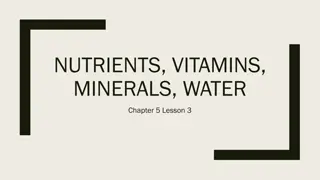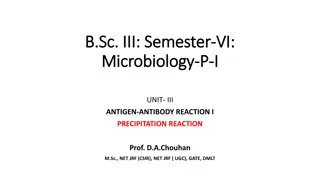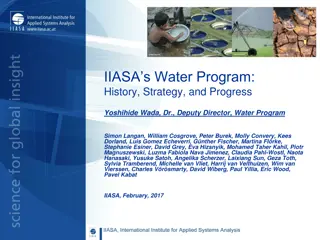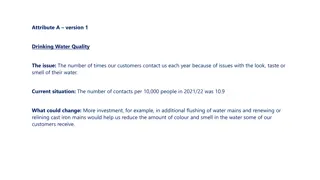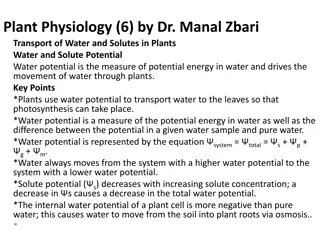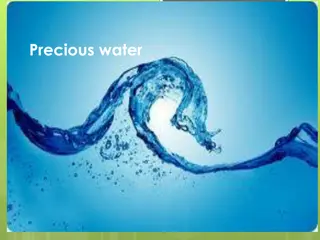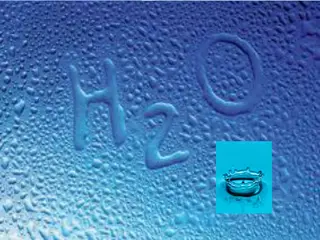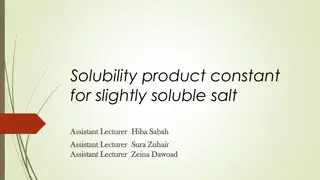Water-Soluble Vitamins and Their Importance
Vitamins are essential micronutrients vital for good health and growth. Water-soluble vitamins, such as B complex and vitamin C, play key roles in energy production and maintaining various bodily functions. Sources, functions, deficiency symptoms, and recommended intakes of water-soluble vitamins are outlined. It's crucial to consume foods rich in these vitamins regularly to support overall well-being.
Download Presentation

Please find below an Image/Link to download the presentation.
The content on the website is provided AS IS for your information and personal use only. It may not be sold, licensed, or shared on other websites without obtaining consent from the author.If you encounter any issues during the download, it is possible that the publisher has removed the file from their server.
You are allowed to download the files provided on this website for personal or commercial use, subject to the condition that they are used lawfully. All files are the property of their respective owners.
The content on the website is provided AS IS for your information and personal use only. It may not be sold, licensed, or shared on other websites without obtaining consent from the author.
E N D
Presentation Transcript
Nutrition and Health Micronutrients - Vitamins
Topics Vitamins Water-soluble vitamins vitamin B vitamin C Fat-soluble vitamins vitamin A vitamin D vitamin E vitamin K 2
VITAMINS 3
Vitamins Vitamins are micronutrients They are natural substances found in foods that have different functions in the human body The human body needs them in very small quantities Vitamins are essential for good health and growth There are two groups of vitamins water-soluble vitamins fat-soluble vitamins 4
Water-Soluble Vitamins Water-soluble vitamins dissolve in water The excess water-soluble vitamins from intake will be excreted through urination and cannot be stored in the body Therefore, foods rich in these vitamins need to be consumed regularly Water-soluble vitamins are heat-unstable, and can be lost upon heat treatment of food Water-soluble vitamins include: - vitamin B complex (thiamine, riboflavin, niacin, pyridoxine, folate, cobalamin) - vitamin C 6
Water-Soluble Vitamins Vitamins Functions Sources Deficiency Reference Nutrient Intakes (RNI) ** for adults per day Vitamin B1 (Thiamine) Helps the release of energy from nutrients Cereals, meat, liver, milk and dairy products, eggs and vegetables (including potatoes) Shortage slows growth and development Mild deficiency causes tiredness and depression Severe deficiency causes beriberi Men: 1.0 mg Women: 0.8 mg Increase intake during pregnancy and lactation Vitamin B2 (Riboflavin ) Needed for healthy skin Helps release energy to cells and in the body s use of carbohydrates Cereals, milk and dairy products, meat, liver, kidney, eggs, green vegetables Shortage slows growth and development May cause skin and eye problems Men: 1.3 mg Women: 1.1 mg Increase intake during pregnancy and lactation Vitamin B3 (Niacin) Involved in the energy producing reactions Helps in maintaining healthy nervous system and skin Meat (especially offal), cereals, potatoes, bread Severe deficiency causes pellagra Symptoms include diarrhoea, dementia and dermatitis Men: 17.0 mg Women: 13.0 mg Increase intake during pregnancy and lactation 7 ** Source: British Nutrition Foundation
Water-Soluble Vitamins Vitamins Functions Sources Deficiency Reference Nutrient Intakes (RNI) ** for adults per day Vitamin B6 (Pyridoxine) Needed for the metabolism of protein Helps formation of red blood cells and proper functioning of the nervous system Liver, kidney, fish, wheat germ, poultry, leafy vegetables, potatoes, cereals Rare, but deficiency in infants can cause convulsions Men: 1.4 mg Women: 1.2 mg Vitamin B9 (Folate) Needed for red blood cell production Cereals, nuts and pulses, leafy vegetables (such as spinach) Mild deficiency leads to tiredness A folate deficiency can cause megaloblastic anaemia Deficiency in the early stages of pregnancy is associated with neural tube defects in foetus 200 g Increase intake during pregnancy and lactation Woman planning pregnancy, or in the first 12 weeks, should supplement their diet with 0.4 mg per day ** Source: British Nutrition Foundation 8
Water-Soluble Vitamins Vitamins Functions Sources Deficiency Reference Nutrient Intakes (RNI) ** for adults per day Vitamin B12 (Cobalamin) Helps prevent certain forms of anaemia Helps cells divide Protects nervous system All animal foods liver, fish, meat, cheese, milk, eggs Deficiency can lead to pernicious anaemia and neurological problems 1.5 g Vitamin C (Ascorbic Acid) Maintains body s connective tissue, important for wound healing Helps iron absorption Has antioxidant properties Fruits and vegetables, especially citrus fruits (including oranges and lemons) Deficiency may cause scurvy 40 mg ** Source: British Nutrition Foundation 9
VITAMIN B 10
Vitamin B Scientists originally thought there was only one vitamin B, but then discovered that there were several more that had similar functions in the body They are all grouped together and are known as the vitamin B complex , such as - vitamin B1 (thiamine) - vitamin B2 (riboflavin) - vitamin B3 (niacin) - vitamin B6 (pyridoxine) - vitamin B9 (folate) - vitamin B12 (cobalamin) 11
Functions of Vitamin B1 (Thiamine) Helps release energy from carbohydrates Helps the body grow Helps the nerves work properly 12
Sources of Vitamin B1 (Thiamine) Vitamin B1 is not stored in the body, so a continuous daily supply is needed Foods that provide vitamin B1 : cereals such as wheat and rice (especially whole grain) and cereal products meat (especially pork, bacon and ham) and offal (especially liver, kidney and heart) eggs, fish roe milk and dairy products seeds, nuts, beans 13
Deficiency of Vitamin B1 (Thiamine) Deficiency of vitamin B1 can cause beriberi A diet low in thiamine Beriberi Dry beriberi Wet beriberi Damages the nerves and can lead to decreased muscle strength and eventually, muscle paralysis Affects the heart and circulatory system, and can cause heart failure 14
Beriberi A diet with a good supply of vitamin B1 Adopt a balanced diet Prevention of beriberi 15
Functions of Vitamin B2 (Riboflavin) Helps release energy from carbohydrates, fats and proteins Needed for growth in children 16
Sources of Vitamin B2 (Riboflavin) Foods that provide vitamin B2: cereals such as wheat and rice (especially whole grain) and cereal products meat (especially pork, bacon and ham) and offal (especially liver, kidney and heart) eggs, fish roe milk and dairy products seeds, nuts, beans 17
Deficiency of Vitamin B2 (Riboflavin) Low intake can lead to dryness and peeling skin on the nose, cracks and redness at the corners of mouth, and a swollen tongue It affects vision, including blurred vision, sensitivity to light, itchy and watering eyes 18
Functions of Vitamin B3 (Niacin) Helps release energy from food Used to lower the levels of fat in the blood 19
Sources of Vitamin B3 (Niacin) Foods that provide vitamin B3: cereals such as wheat and rice (especially whole grain) and cereal products meat (especially pork, bacon and ham) and offal (especially liver, kidney and heart) eggs, fish roe milk and dairy products seeds, nuts, beans Although the liver can synthesise niacin from tryptophan (a kind of amino acid), the speed is extremely slow 20
Deficiency of Vitamin B3 (Niacin) Deficiency of vitamin B3 can cause pellagra The symptoms of pellagra are known as the three D s: Diarrhoea Dermatitis (rough and sore skin) Dementia (confusion, memory loss, unable to speak properly) 21
Excess of Vitamin B3 (Niacin) Very high dosage may cause liver damage 22
Functions of Vitamin B6 (Pyridoxine) Helps the body use protein, fat and carbohydrate Involved in enzyme reactions and protein metabolism in the body 23
Sources of Vitamin B6 (Pyridoxine) Foods that provide vitamin B6: liver and kidney poultry fish wheat germ, cereals leafy vegetables potatoes 24
Deficiency of Vitamin B6 (Pyridoxine) Vitamin B6 deficiency is associated with: headaches general aching and weakness anaemia 25
Excess of Vitamin B6 (Pyridoxine) High dosage may induce poor functioning of sensory nerves 26
Functions of Vitamin B9 (Folate) Folate is the natural form of the vitamin found in food, folic acid is the man-made vitamin in supplements and added to foods Helps the body use protein Important in making red blood cells Involved in the synthesis and repair of DNA (deoxyribonucleic acid) in the body cells Aids rapid cell division and growth, especially the cells in the bone marrow Folate helps prevent the foetus from developing major congenital deformities of the brain or spine, including neural tube defects 27
Sources of Vitamin B9 (Folate) Foods that provide folate: green and leafy vegetables (e.g. spinach and Chinese kale) liver fruits (e.g. oranges and berries) asparagus, okra beans (e.g. mung beans and red beans) and peas (e.g. chickpeas) 28
Deficiency of Vitamin B9 (Folate) Deficiency of folate can lead to a wide range of problems including: effects in the digestive system, such as loss of appetite, nausea, diarrhoea and soreness in the mouth megaloblastic anaemia red blood cells are not fully mature and become larger and fewer than normal therefore, not able to carry enough oxygen to body tissues congenital deformities in foetus 29
Effects of Deficiency of Vitamin B9 (Folate) in the Digestive System Inadequate intake of folate or folic acid Cells in the digestive system are not dividing properly Other nutrients are not absorbed Loss of appetite, nausea, diarrhoea and soreness in the mouth 30
Megaloblastic Anaemia Inadequate intake of folate or folic acid Red blood cells in the bone marrow are not dividing and mature properly Red blood cells become very large and are not able to deliver enough oxygen around the body Shortness of breath, muscle weakness, extreme tiredness, a lack of energy 31
Congenital Deformities in Foetus Very high demand of folate or folic acid during pregnancy (about 5 times more than normal) Pregnant women do not have adequate intake of folate or folic acid before conception Improper development of embryo during early stage of pregnancy Spina bifida occurs in foetus a congenital deformity in the spine 32
Functions of Vitamin B12 (Cobalamin) Cobalamin is needed to form a protective coating around nerve cells to make them work properly Important for the production of new cells 33
Sources of Vitamin B12 (Cobalamin) Cobalamin can be stored in the liver Synthesised only by microorganisms Therefore, only presents in animal foods; none in plant foods, such as meat and liver poultry and egg fish milk and dairy products 34
Deficiency of Vitamin B12 (Cobalamin) Prevents the nerves from working properly and leads to: numbness or tingling, muscle weakness, and problem in walking paralysis, memory loss and confusion People who have problem absorbing cobalamin can develop pernicious anaemia a condition in which the body does not have enough healthy red blood cells 35
VITAMIN C 36
Functions of Vitamin C (Ascorbic Acid) Enable the body to absorb iron from food For the production of collagen (a kind of protein) in the body Collagen is the protein in connective tissue which is the substance that binds the body cells together As an antioxidant which helps protect the body from polluting chemicals that get into the body from the air, water or in food 37
Sources of Vitamin C (Ascorbic Acid) Foods that provide vitamin C: fruits, e.g. citrus fruits, kiwi fruit vegetables, e.g. green, leafy vegetables (except for lettuce), broccoli, green peppers, potatoes There is a very small amount of vitamin C in liver and fresh milk 38
Deficiency of Vitamin C (Ascorbic Acid) A deficiency is rare but is occasionally found in the elderly and children who have very little fresh fruits and vegetables in their diet Slight deficiency of vitamin C may cause anaemia because not enough iron is absorbed 39
Deficiency of Vitamin C (Ascorbic Acid) A severe deficiency causes scurvy with the following symptoms: bleeding gums poor wound healing damage to bone and other tissues 40
Deficiency of Vitamin C (Ascorbic Acid) Inadequate intake of vitamin C Inadequate formation of collagen Anaemia Tiredness Weakness Scurvy Damage to bone and other tissues Bleeding gums Poor wound healing 41
Fat-Soluble Vitamins Fat-soluble vitamins dissolve in fats The excess fat-soluble vitamins from intake will be stored in the body (liver and fatty tissue) The body can retrieve these vitamins when needed, therefore, can consume less than daily need Fat serves as a medium for the body to absorb these vitamins Fat-soluble vitamins are relatively heat-stable as compared to water-soluble vitamins Fat-soluble vitamins include: - vitamin A - vitamin D - vitamin E - vitamin K Some fat-soluble vitamins can be easily oxidised, e.g. vitamin A and E 43
Fat-Soluble Vitamins Vitamins Functions Sources Deficiency Reference Nutrient Intakes (RNI) ** for adults Vitamin A retinol (animal origin) Good for night vision, healthy skin and tissue Liver, oily fish, whole milk, butter, margarine, cheese, eggs Long-term deficiency may lead to night blindness Men: 700 g Women: 600 g Vitamin A beta- carotene (plant origin) Beta-carotene is an antioxidant vitamin which might protect against cancer Carrots, green vegetables, orange and red fruits and vegetables Vitamin D Works with calcium to form healthy bones and teeth The skin can make vitamin D after exposure to sunlight Margarine, oily fish, liver Deficiency in children can cause rickets 10 g ** Source: British Nutrition Foundation 44
Fat-Soluble Vitamins Vitamins Functions Sources Deficiency Reference Nutrient Intakes (RNI) ** for adults per day Vitamin E Good for healthy skin. May help protect against heart disease Eggs, nuts, seeds, cereal products, vegetable oils Deficiency is rare, normally enough supply in a balanced diet No RNIs but safe intakes have been set at more than 4 mg for men and more than 3 mg for women Vitamin K Involved with clotting of blood Green vegetables, pulses, fruits, cereals, meat, liver Also made by bacteria in the large intestine Deficiency is rare, normally enough supply in a balanced diet No RNIs but safe intake is 1 g per 1 kg body weight ** Source: British Nutrition Foundation 45
VITAMIN A 46
Functions of Vitamin A Helps the body grow and develop Keeps the lining of the throat, the digestive system and the lungs moist and free from infection Keeps the skin healthy Makes a substance in the retina so the eyes can see well enough in dim light As an antioxidant which helps stop substances that get into the body from the air, water and foods from damaging it 47
Sources of Vitamin A Vitamin A can be found in foods in two different forms: Retinol is pure vitamin A primarily found in animal sources that contain fat, e.g. milk, cheese, butter, oily fish (e.g. tuna, mackerel, sardines) and liver Beta-carotene is a precursor of vitamin A found in plant foods, e.g. carrots, oranges, red peppers, dark green leafy vegetables, tomatoes and pumpkin 48
Deficiency of Vitamin A Children do not grow properly Difficult for the body to fight infection Develops night blindness which is a condition of not being able to see in dim light and will eventually lead to blindness 49
Excess of Vitamin A Too much vitamin A is poisonous to the body May lead to liver and bone damage 50
